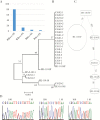High Plasmodium Infection Rate and Reduced Bed Net Efficacy in Multiple Insecticide-Resistant Malaria Vectors in Kinshasa, Democratic Republic of Congo
- PMID: 29087484
- PMCID: PMC5853898
- DOI: 10.1093/infdis/jix570
High Plasmodium Infection Rate and Reduced Bed Net Efficacy in Multiple Insecticide-Resistant Malaria Vectors in Kinshasa, Democratic Republic of Congo
Abstract
Accounting for approximately 11% of all malaria cases, the Democratic Republic of the Congo (DRC) is central to malaria elimination efforts. To support vector control interventions in DRC, we characterized the dynamics and impact of insecticide resistance in major malaria vectors in 2015. High Plasmodium infection rates were recorded in Anopheles gambiae and Anopheles funestus, with Plasmodium falciparum predominant over Plasmodium malariae. Both mosquito species exhibited high and multiple resistance to major public health insecticide classes. The extremely high resistance to permethrin and DDT (dichlorodiphenyltrichloroethane) in An. gambiae (low mortalities after 6 hours exposure) is worrisome, and is supported by a reduced insecticidal effect of bed nets against both mosquito species in laboratory tests. Metabolic and target site insensitivity mechanisms are driving this resistance in An. gambiae, but only the former was observed in An. funestus. These findings highlight the urgent need for actions to prolong the effectiveness of insecticide-based interventions in DRC.
Keywords: Anopheles; Democratic Republic of Congo; Plasmodium falciparum; insecticide resistance; malaria.
© The Author(s) 2017. Published by Oxford University Press for the Infectious Diseases Society of America.
Figures





References
-
- US President’s Malaria Initiative. Democratic Republic of the Congo malaria operational plan, fiscal year 2016. https://www.pmi.gov/docs/default-source/default-document- library/malari.... Accessed 14 April 2017.
-
- World Health Organization. Global plan for insecticide resistance management in malaria vectors. Geneva, Switzerland: WHO, 2012.
-
- Basilua Kanza JP, El Fahime E, Alaoui S et al. . Pyrethroid, DDT and malathion resistance in the malaria vector Anopheles gambiae from the Democratic Republic of Congo. Trans R Soc Trop Med Hyg 2013; 107:8–14. - PubMed
-
- US President’s Malaria Initiative. Democratic Republic of the Congo malaria operational plan, fiscal year 2014. https://www.pmi.gov/docs/default-source/default-document-library/malaria.... Accessed 14 April 2017.
-
- Bobanga T, Ayieko W, Zanga M et al. . Field efficacy and acceptability of PermaNet® 3.0 and OlysetNet® in Kinshasa, Democratic Republic of the Congo. J Vector Borne Dis 2013; 50:206–14. - PubMed
Publication types
MeSH terms
Substances
Grants and funding
LinkOut - more resources
Full Text Sources
Other Literature Sources
Miscellaneous

